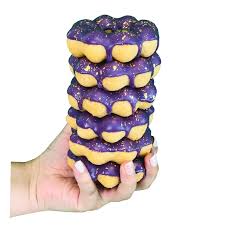The Global Dessert Awakening

In the world of sweets, trends come and go like seasonal winds. Cupcakes once ruled the early 2010s. Macarons had their Instagram moment. But as we enter the mid-2020s, one chewy, bouncy, colorfully glazed dessert has quietly taken center stage.
Enter the mochi donut — the sweet treat that’s not just a snack but an experience.
From bustling bakeries in Tokyo to hip cafes in New York, Seoul, and London, mochi donuts have quickly become more than just a novelty. They represent a global craving for texture-driven desserts, cultural crossover, and playful presentation — all wrapped into a delightfully ring-shaped package.
But what exactly makes mochi donuts the dessert of the moment? And why is everyone suddenly obsessed?
Let’s find out.
What Exactly Is a Mochi Donut?
A mochi donut is a hybrid dessert, blending the chewy, stretchy texture of Japanese mochi (made with glutinous rice flour) with the crispy, deep-fried exterior of a traditional American-style donut.
Its distinct pon de ring shape (eight small dough balls connected in a ring) isn’t just adorable—it plays a major role in texture. That “pull-apart” design creates a uniquely soft yet bouncy bite in every piece.
Depending on where you eat it, a mochi donut might be:
- Fried or baked
- Made from sweet rice flour, tapioca starch, or both
- Glazed with matcha, ube, black sesame, strawberry milk, or crème brûlée sugar
The possibilities are endless. But the texture—that crispy exterior with a chewy interior—is always at the heart.
A Brief History: From Kyoto to California
To understand the rise of mochi donuts, we need to rewind a bit.
- Mochi, the chewy rice cake made from glutinous rice, has been a part of Japanese culture for over a thousand years. It’s eaten during New Year celebrations, weddings, and even in modern street snacks like daifuku or mochi ice cream.
- In the early 2000s, Japan’s Mister Donut introduced the “Pon de Ring”, inspired by Brazilian pão de queijo (cheese bread made from tapioca). It became an instant classic, thanks to its addictive bounce.
- Fast forward to the late 2010s: Asian-American bakers on the U.S. West Coast began experimenting with hybrid desserts. From mochi brownies to ube cheesecake, the wave was coming. And then it hit: mochi donuts began popping up in cities like Los Angeles, Seattle, and Vancouver.
By 2020, the trend was in full swing.
The Texture Revolution: Why the Chew Matters

Modern dessert lovers aren’t just chasing sweetness—they’re obsessed with mouthfeel.
There’s something almost primal about that chewy resistance. It triggers sensory satisfaction in a way that creaminess or crunch alone cannot. In Japan, it’s called “mochitto” — the soft stretchiness that feels nostalgic, comforting, even addictive.
This texture trend is not limited to mochi:
- Boba pearls
- Korean rice cakes (tteok)
- Tangyuan (Chinese glutinous rice balls)
All have gained international fame because of their unique chewiness.
Mochi donuts tap into this exact craving — offering a light crisp followed by a bouncy interior, unlike any other pastry on the shelf.
Mochi Donuts vs. Traditional Donuts
Let’s break it down:
| Feature | Mochi Donuts | Traditional Donuts |
|---|---|---|
| Texture | Chewy, elastic, light crunch | Soft, fluffy, cakey or doughy |
| Ingredients | Sweet rice flour, tapioca | All-purpose flour, yeast or baking powder |
| Shape | Ring with pearls (pon de ring) | Classic ring or filled circle |
| Flavors | Asian-inspired (matcha, black sesame) | Glazed, chocolate, jelly |
| Gluten-free | Often, yes | Rarely |
So while the traditional donut offers comfort and familiarity, the mochi donut is a playful twist—a remix that feels new and exciting.
Cultural Fusion: East Meets West in One Bite
At its heart, the mochi donut is a culinary love story between Japanese rice traditions and Western-style indulgence. And in a world increasingly connected through travel, social media, and cross-cultural exchange, it just makes sense.
Think about it:
- U.S. coffee chains now offer matcha lattes
- Parisian bakeries are selling yuzu-flavored eclairs
- K-pop fans in Brazil are baking bungeoppang with dulce de leche
Mochi donuts fit this cultural blend perfectly — rooted in Japanese tradition but open to wild global interpretation.
Viral Magic: TikTok, Instagram & The Visual Appeal
In the age of “camera eats first,” mochi donuts were destined to win.
That pon de ring design? Photogenic.
That rainbow of glazes and toppings? Scroll-stopping.
That soft pull-apart interior? Perfect for video ASMR.
Top social platforms like TikTok, Instagram Reels, and YouTube Shorts are flooded with:
- Time-lapse mochi donut bakes
- “Cut-open” videos showing the stretch
- Side-by-side flavor taste tests
- DIY tutorials with colorful glazes and edible flowers
A mochi donut isn’t just a dessert. It’s a content engine.
The DIY Craze: Mochi Donuts at Home
One major reason for the mochi donut boom? It’s surprisingly easy to make at home.
During pandemic lockdowns, bakers all over the world experimented with:
- Sweet rice flour (Mochiko or shiratamako)
- Tapioca starch
- Coconut milk, for extra flavor
- Gluten-free variations
- Air fryer-friendly recipes
The result? Pinterest exploded. YouTube cooking channels began offering endless variations. And home cooks discovered that mochi donuts were not only delicious but customizable and fun to decorate.
How Local Bakeries Are Reinventing the Trend

Every culture is now giving mochi donuts its own local spin.
- In Hawaii, mochi malasadas mix Portuguese tradition with Japanese influence.
- In Toronto, ube and pandan flavors dominate the shelves.
- In Paris, pastry chefs are pairing mochi donut dough with creme patissiere or brûlée crusts.
- In Dubai, date syrup and pistachio glazes are trending.
Each new twist shows how adaptable and evolving this sweet fusion truly is.
Mochi Donut Flavors Taking Over the Internet
Some of the most viral and beloved mochi donut flavors include:
- Matcha White Chocolate
- Black Sesame & Honey
- Strawberry Milk
- Taro Coconut
- Cookies & Cream
- Cereal Milk Crunch
- Earl Grey Lavender
- Churro Cinnamon Glaze
Limited edition drops, seasonal sets, and flavor-of-the-month programs are fueling a dessert culture that’s playful, dynamic, and constantly evolving.
Is It Just a Fad? Or the Future of Sweets?
Skeptics say mochi donuts are “just another TikTok dessert.” But the numbers — and cultural impact — say otherwise.
The chewy texture trend is not slowing down. If anything, it’s moving deeper into the mainstream.
Brands are already launching:
- Mochi donut ice cream sandwiches
- Mochi donut kits for kids
- Pop-up collabs with major cafes like Starbucks and Peet’s
What we’re seeing is not a fad. It’s a movement.
Closing Thoughts & What’s Coming
Mochi donuts are more than just a sweet. They’re a statement.
They say:
- “We love texture.”
- “We celebrate cross-cultural creativity.”
- “We want food that makes us smile — and makes our followers hungry.”
Mochi Donuts Go Mainstream: When Niche Becomes Mass
Once a novelty found in trendy bakeries or K-pop-themed cafés, mochi donuts are now being mass-produced, exported, and franchised across continents.
- In 2022, there were fewer than 100 mochi donut shops in the U.S.
- By mid-2025, there are over 1,500 dedicated locations worldwide.
Major food trend publications like Eater, Delish, and Food & Wine are now profiling mochi donuts as “the next big thing” after bubble tea.
The Rise of Mochi Donut Franchises

Leading the way are brands like:
- Mochinut – Now operating in 16+ countries
- Dochi – Seattle-born, now with 50+ locations
- Pon de Joy, The Mochi Bar, and MochiCraft
These businesses offer turnkey franchise kits including:
- Custom flour blends
- Training videos and backend POS systems
- Aesthetic interior designs
- Branding packages for TikTok and Instagram campaigns
They are succeeding because mochi donuts are:
- Compact (low real estate needs)
- Viral (marketing is often free via social shares)
- High-margin (ingredients are inexpensive vs price point)
What It Takes to Start a Mochi Donut Business
Startup Cost Range:
- Low-end (kiosk or cart): ~$20,000–30,000
- Mid-range (café model): ~$50,000–100,000
- High-end (flagship location): $150,000+
Main Needs:
- Rice flour + tapioca starch supplier
- Donut fryer or air fryer
- Experienced baker or chef
- Licenses for food prep and hygiene
- Social media-first brand identity
Franchises help—but many indie entrepreneurs are finding success by offering culturally customized flavors: Thai milk tea in Bangkok, guava cream in Puerto Rico, saffron rose in Dubai.
Cost Breakdown: Startup to Scale
Per donut (ingredient cost): ~$0.25–$0.40
Retail price (average): $2.75–$4.50
Profit margin (gross): 70–80%
Key cost centers:
- Labor and training
- Rent (though many run in food trucks or stalls)
- Branding + packaging
- Licensing (especially in Europe and U.S.)
But the ROI is exceptional, especially in high-footfall urban zones or near college campuses.
Mochi in Supermarkets: The Retail Goldmine

Some brands now offer:
- Pre-packaged mochi donuts in the freezer aisle
- Mochi donut mix kits for at-home bakers
- Mini versions in gas stations, 7-Eleven, and Costco in Asia
This shift to retail is important because:
- It creates brand loyalty at home
- It offers convenience and snackability
- It opens up co-branding with cereal, candy, and coffee giants
Mochi Meets Tech: Ghost Kitchens & Delivery-Only Shops
With food delivery booming, mochi donut shops have joined the “ghost kitchen” revolution:
- Shared kitchens that produce for Uber Eats/Doordash only
- No storefront = minimal rent
- Menu optimized for delivery: warmable mochi boxes, sauces on side
Some even offer mochi donut subscriptions — like a donut-of-the-month club.
Mochi Donuts and the Future of Fast-Casual
As we move away from sit-down dessert chains, mochi donuts offer:
- Quick prep
- Modular packaging
- Shareable portions
- Cross-sell potential with bubble tea, coffee, ice cream
They fit perfectly in co-branded dessert cafés, making them ideal for malls, universities, airports, even amusement parks.
Healthier Than You Think? Nutrition and Labeling
While still a dessert, mochi donuts:
- Are often gluten-free
- Use less oil than traditional donuts
- Can be made with coconut milk or natural fruit purees
- Have fewer preservatives when made fresh daily
Health-conscious brands are marketing them as “mindful indulgence.”
Some are even experimenting with:
- Keto-friendly rice flours
- Plant-based fillings
- Sugar alternatives like monk fruit
How Global Brands Are Adopting the Trend
- Starbucks Korea tested limited-time mochi donut collabs.
- Dunkin’ Japan released pon de ring–inspired flavors.
- Trader Joe’s rumored to explore frozen mochi donut packs.
- Uber Eats launched mochi-themed promo weeks in NYC and LA.
Mochi donuts are no longer indie — they’re heading mainstream in foodservice, retail, and delivery.
Mochi in Pop Culture and Media
Mentions are now regular in:
- K-Dramas and anime scenes
- TikTok “what I eat in a day” videos
- Mochi-themed cookbooks and coloring books
- Netflix food series (e.g., Street Food Asia)
Even celebrities are joining in. BTS fans made mochi donuts trend worldwide after a fan-designed flavor went viral in Seoul.
Next Frontier: Mochi Fusion 2.0
The next generation of mochi-inspired desserts is already brewing:
- Mochi Donut Ice Cream Sandwiches
- Savory mochi donuts (cheese, onion, jalapeño)
- Mochi churros
- 3D-printed mochi art
There are also whispers of automated mochi donut kiosks, much like ramen ATMs or cupcake dispensers.
And of course — mochi donuts in the metaverse. Yes, NFT-based donut art and VR baking classes are a thing.
Final Words: Is This Just the Beginning?
The mochi donut may have started as a humble fusion of rice and ring. But today, it’s a global phenomenon, a business model, a cultural ambassador, and a digital star.
Whether you’re an investor, a foodie, or just someone curious about trends — this sweet, chewy creation offers more than a sugar rush. It offers a taste of the future of desserts.
Key Takeaway:
Mochi donuts are not just trending—they are transforming how we bake, brand, and bite into culture.
